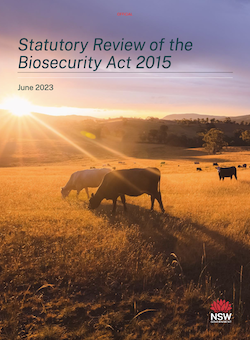
Statutory Review of the Biosecurity Act 2015
Protecting NSW Biosecurity Industries and the Environment - The NSW Department of Primary Industries (NSW DPI) have completed the statutory review of the Biosecurity Act 2015 (the Act).
Biosecurity protects our economy, environment and community from pests, diseases, weeds and contaminants. We have great access to fresh food, fibre, open spaces and a unique environment. It is crucial that we are able to effectively minimise the impact of the biosecurity threats already present within our borders. Increased global trade, recreational travel and population are contributing to increased biosecurity risks. NSW and Australia are fortunate to be free of many pests and diseases that impact other countries.
Section 406 of the Act requires a statutory review of the Act within twelve months after a period of five years from its commencement. The purpose of this review is to determine whether the following policy objectives remain valid and whether the terms of the Act remain appropriate for securing those objectives.
The primary object of the Act is to:
"...provide a framework for the prevention, elimination and minimisation of biosecurity risks posed by biosecurity matter, dealing with biosecurity matter, carriers and potential carriers, and other activities that involve biosecurity matter, carriers, or potential carriers."
The other objects of the Act are:
- to promote biosecurity as a shared responsibility between government, industry, and communities
- to provide a framework for the timely and effective management of the following:
- pests, diseases, contaminants, and other biosecurity matter that are economically significant for primary production industries
- threats to terrestrial and aquatic environments arising from pests, diseases, contaminants, and other biosecurity matter
- public health and safety risks arising from contaminants, non-indigenous animals, bees, weeds, and other biosecurity matter known to contribute to human health problems
- pests, diseases, contaminants, and other biosecurity matter that may have an adverse effect on community activities and infrastructure
- to provide a framework for risk-based decision-making in relation to biosecurity
- to give effect to intergovernmental biosecurity agreements to which the State is a party
- to provide the means by which biosecurity requirements in other jurisdictions can be met, so as to maintain market access for industry
 Statutory Review of the Biosecurity Act 2015 Report tabled in Parliament
Statutory Review of the Biosecurity Act 2015 Report tabled in Parliament
The NSW Government has reviewed the Act to determine whether the policy objectives of the Act remain valid and whether the terms of the Act remain appropriate for securing those objectives.
The Review has provided an opportunity to:
- Make sure the Act is protecting our economy, environment and community from pests, diseases, weeds and contaminants
- Check the level of understanding and awareness of shared responsibility by the community and industry
- Consider if the Act’s emergency response and compliance tools have effectively protected the NSW economy, environment and community from pests, diseases, weeds and contaminants, and will remain effective in meeting future biosecurity challenges.
- Re-engage with our industry and community partners on the importance of biosecurity
- Measure levels of biosecurity awareness and understanding in the community
- Ensure market access is properly supported and maintained; and
- Make sure we can continue to meet future biosecurity challenges.
To inform the review the following pieces of work were undertaken:
- An independent attitudinal and awareness study (Attitudinal Research)
- Desktop research analyzing other jurisdictions’ biosecurity frameworks
- Consideration of current and emerging biosecurity risks
- Discussion paper developed with key internal stakeholder input and released to enable public consultation
- Targeted consultation with key stakeholders, industry and the broader community.
The Review found that the policy objectives of the Act and its supporting legislation remain valid, and the terms of the Act remain appropriate for securing those objectives. Nine recommendations have been identified to further mature the regulatory framework and to ensure it remains fit for purpose and flexible to address current and emerging biosecurity risks in New South Wales.
The recommendations are grouped into four key themes:
- Education, communications, and training to bolster our shared biosecurity responsibility: improved education, training, communications, and tools to assist our stakeholders (the general community, land holders and control authorities) to understand and fulfill their biosecurity responsibilities, such as the General Biosecurity Duty.
- Biosecurity Management Practices: providing improved clarity of roles and responsibilities across public and private land, embedding the use of current management tools via Biosecurity Management Plans and further consultation with stakeholders to determine feasible options for biosecurity risk management on the land.
- Supporting the administration of the Act: review current policy and procedures under the Act and its subordinate legislation for delivery improvements, such as listing processes.
- Sustainable biosecurity system: identify further options for ongoing, sustainable resourcing, such as fees and levies with the application of charges on risk creators and beneficiaries.
Next Steps:
NSW DPI will continue to work with stakeholders to address the feedback and recommendations identified in the Review. NSW DPI will also consider appropriate actions to address the identified recommendations.
Please read the following documents for more information:

